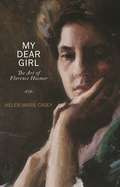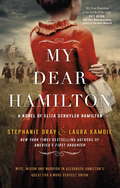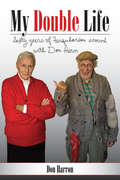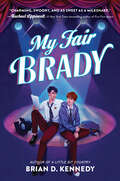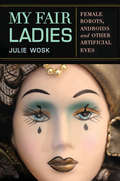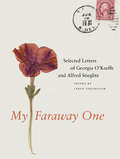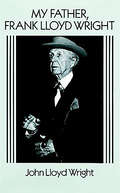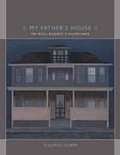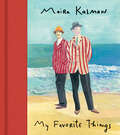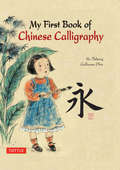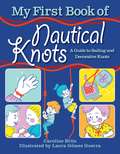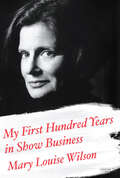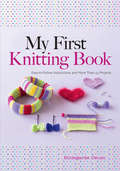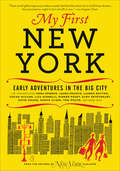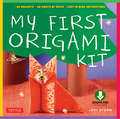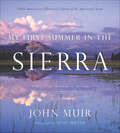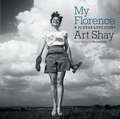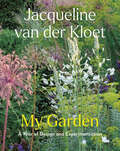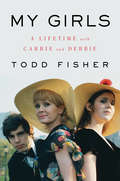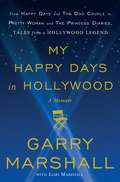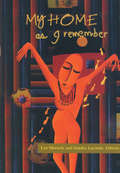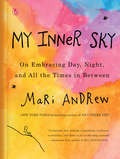- Table View
- List View
My Dear Girl
by Helen Marie CaseyFlorence Armes Hosmer, born in 1880, was a farmer's daughter determined to succeed as an artist. Acclaimed in the early part of the twentieth century, she has fallen almost entirely from view. This is the story of how Miss Hosmer, a feisty New England woman, painted her way through the new century and created well more than five hundred works.Helen Marie Casey won the fourteenth National Poet Hunt in 2009. Helen's published two poetry chapbooks, Fragrance Upon His Lips, a series of poems about Joan of Arc, and Inconsiderate Madness, which won the 2005 Black River Chapbook Competition.
My Dear Hamilton: discover Eliza's story . . . perfect for fans of hit musical Hamilton!
by Stephanie Dray Laura KamoieLove Lin-Manuel Miranda's hit musical Hamilton? Discover the untold story of the brilliant Eliza Schuyler Hamilton!Coming of age in revolutionary New York, Elizabeth Schuyler is proud to champion the fight for independence. And when she meets Alexander Hamilton, Washington's penniless but passionate right hand man, she's captivated by the young officer's charisma and brilliance. Despite the perilous times and Alexander's background, they fall in love and are soon married. From glittering balls to bloody street riots, the Hamiltons are at the centre of it all - including America's first sex scandal, which forces Eliza to struggle through heartbreak and betrayal to find forgiveness. And when a duel destroys Eliza's hard-won peace, the grieving widow fights her husband's enemies to preserve Alexander's legacy. But long-buried secrets threaten everything Eliza believes about her marriage and her own legacy. Questioning her tireless devotion to the man and country that have broken her heart, she's left with one last battle - to understand the flawed man she married and imperfect union he could never have created without her . . .Haunting, moving, and beautifully written, Dray and Kamoie use thousands of letters and original sources to tell Eliza's story as it's never been told before - not just as the wronged wife but as a strong woman who shaped an American legacy in her own right.'Full of history, engaging characters who shimmer on each page, and a tremendous love story, this is a book for everyone' Karen White, New York Times bestselling author'An unforgettable story of the woman behind Hamilton - a triumph!' Pam Jenoff, New York Times bestselling author'My Dear Hamilton is the book of the year' Kate Quinn, USA Today bestselling author of The Alice Network'Historical fiction at its most addictive!' Stephanie Thornton, author of The Tiger Queens'An incredible, surprising, and altogether lovely tribute to the woman who stood beside one of the most unknowable, irascible, energetic, and passionate of men' Lars Hedbor, author of The Path: Tales from a Revolution
My Double Life: Sexty Yeers of Farquharson Around with Don Harn
by Don HarronThe colourful story of Don Harron’s 77-year career in the entertainment business. After 15 books about somebody else (mostly alter ego Charlie Farquharson) plus one book by his drag-queen character, Charlie’s rich city cousin Valerie Rosedale, Don Harron now presents the story of his 77-year stint in the entertainment business. The actor’s colourful career includes such highlights as making money in 1935 as a 10-year-old cartoonist doing mother-and-son banquets; winning an ACTRA Award as best radio host for Morningside; six stage shows on Broadway, three in London’s West End, and 10 years of Shakespeare in three countries; a Gemini Award for lifetime achievement; writing the lyrics for five musicals, including Anne of Green Gables; and being appointed to the Canadian Country Music Hall of Honours due to his appearances on Hee Haw. Whether playing a serious stage role or hamming it up as Charlie Farquharson, Harron is always insightful and provides a unique perspective on a long life in the entertainment business.
My Drunk Kitchen
by Hannah HartOne day, lonely cubicle dweller and otherwise bored New York City transplant Hannah Hart decided to make a fake cooking show for a friend back home in California. She opened her laptop, pulled out some bread and cheese, and then, as one does, started drinking. The video was called "Butter Yo Sh*t" and online sensation My Drunk Kitchen was born.My Drunk Kitchen (the book!) includes recipes, stories, color photographs, and tips and tricks to inspire your own adventures in tipsy cooking. Hannah offers cocktail recommendations, culinary advice (like, remember to turn off the oven when you go to bed), and shares never-before-seen recipes such as: The Hartwich (Knowledge is ingenuity! Learn from the past!) Can Bake (Inventing things is hard! You don't have to start from scratch!) Latke Shotkes (Plan ahead to avoid a night of dread!) Tiny Sandwiches (Size doesn't matter! Aim to satisfy.) Saltine Nachos (It's not about resources! It's about being resourceful.)In the end, My Drunk Kitchen may not be your go-to guide for your next dinner party . . . but it will make you laugh and drink . . . I mean think . . . about life.
My Fair Brady
by Brian D. KennedyMy Fair Lady meets the classic teen film She's All That in this charming and swoony new rom-com from Brian D. Kennedy, author of A Little Bit Country. Perfect for fans of What If It's Us and She Gets the Girl. Wade Westmore is used to being in the spotlight. So when he’s passed over for the lead in the spring musical, it comes as a major blow—especially when the role goes to his ex-boyfriend, Reese, who dumped him for being too self-involved.Shy sophomore Elijah Brady is used to being overlooked. Forget not knowing his name—most of his classmates don’t even know he exists. So when he joins the stage crew for the musical, he seems destined to blend into the scenery.When the two have a disastrous backstage run-in, Elijah proposes an arrangement that could solve both boys’ problems: If Wade teaches Elijah how to be popular, Wade can prove that he cares about more than just himself. Seeing a chance to win Reese back, Wade dives headfirst into helping Elijah become the new and improved “Brady.”Soon their plan puts Brady center stage—and he’s a surprising smash hit. So why is Wade suddenly less worried about winning over his ex and more worried about losing Elijah?
My Fair Ladies
by Julie WoskThe fantasy of a male creator constructing his perfect woman dates back to the Greek myth of Pygmalion and Galatea. Yet as technology has advanced over the past century, the figure of the lifelike manmade woman has become nearly ubiquitous, popping up in everything from Bride of Frankenstein to Weird Science to The Stepford Wives. Now Julie Wosk takes us on a fascinating tour through this bevy of artificial women, revealing the array of cultural fantasies and fears they embody. My Fair Ladies considers how female automatons have been represented as objects of desire in fiction and how "living dolls" have been manufactured as real-world fetish objects. But it also examines the many works in which the "perfect" woman turns out to be artificial--a robot or doll--and thus becomes a source of uncanny horror. Finally, Wosk introduces us to a variety of female artists, writers, and filmmakers--from Cindy Sherman to Shelley Jackson to Zoe Kazan--who have cleverly crafted their own images of simulated women. Anything but dry, My Fair Ladies draws upon Wosk's own experiences as a young female Playboy copywriter and as a child of the "feminine mystique" era to show how images of the artificial woman have loomed large over real women's lives. Lavishly illustrated with film stills, artwork, and vintage advertisements, this book offers a fresh look at familiar myths about gender, technology, and artistic creation.
My Faraway One
by Sarah GreenoughSelected Letters of Georgia O'Keeffe and Alfred Stieglitz volume 1, 1915 - 1933
My Father, Frank Lloyd Wright
by John Lloyd Wright"An anecdotal reminiscence of America's chief living genius by his son -- short, unconventional, amusing and on the whole revealing." -- Book Week.Frank Lloyd Wright is widely regarded as the twentieth century's greatest architect -- an unconventional genius who transformed both residential and commercial building design with his concept of "organic" architecture. During a long and productive life, Wright designed some 800 buildings, received scores of honors and awards, and left an indelible imprint on modern architectural theory and practice.In this charming, readable memoir, Wright the architect and father comes to life through the vivid recollections and firsthand knowledge of his son. John Lloyd Wright characterizes his father as "a rebel, a jolt to civilization, whose romantic theme -- purposive planning and organic unity in inventing and combining forms -- is an epoch in the architecture of the world." His unique view of the "epoch" will intrigue architects, students, and all who admire the work of this visionary and uncompromising spirit. An added attraction of this volume is the inclusion of the complete text of William C. Gannet's The House Beautiful, an extremely rare work designed and printed by Frank Lloyd Wright.
My Father’s House: On Will Barnet's Paintings
by Thomas DummIn My Father's House, the political philosopher Thomas Dumm explores a series of stark and melancholy paintings by the American artist Will Barnet. Responding to the physical and mental decline of his sister Eva, who lived alone in the family home in Beverly, Massachusetts, Barnet began work in 1990 on what became a series of nine paintings depicting Eva and other family members, as they once were and as they figured in the artist's memory. Rendered in Barnet's signature quiet, abstract style, the paintings, each featured in full color, present the ordinary and extraordinary aspects of a twentieth-century American family. Dumm first became acquainted with Barnet and his paintings in 2008. Given his scholarly focus on the lives of ordinary people, he was immediately attracted to the artist's work. When they met, Dumm and Barnet began a friendship and dialogue that lasted until the painter's death in 2012, at the age of 101. This book reflects the many discussions the two had concerning the series of paintings, Barnet's family, his early life in Beverly, and his eighty-year career as a prominent New York artist. Reading the almost gothic paintings in conversation with the writers and thinkers key to both his and Barnet's thinking--Emerson, Spinoza, Dickinson, Benjamin, Cavell, Nietzsche, Melville--Dumm's haunting meditations evoke broader reflections on family, mortality, the uncanny, and the loss that comes with remembrance.
My Favorite Band Does Not Exist
by Robert T. JeschonekSixteen-year-old genius Idea Deity believes that he exists only in the pages of a novel written by a malevolent, omnipotent author . . . and that he will die in chapter 64. Meanwhile, an older teen named Reacher Mirage sings lead vocals for the undercover rock band Youforia . . . a band that exists in Idea’s world only as an Internet hoax that Idea himself perpetuated. Then there’s beautiful and mysterious Eunice Truant, who links their destinies. When Idea and Reacher plunge into the reality of Fireskull’s Revenant, the twisted epic fantasy novel they’ve both been reading, chapter 64 bears down on them like a speeding freight train on an unstoppable collision course. Being trapped in a bad book can be a nightmare. Just ask Idea Deity.
My Favorite Things
by Maira KalmanFrom Maira Kalman, the author of the bestsellers The Principles of Uncertainty and The Elements of Style, comes this beautiful pictorial and narrative exploration of the significance of objects in our lives, drawn from her personal artifacts, recollections, and selections from the collection of the Cooper-Hewitt, Smithsonian Design Museum.With more than fifty original paintings and featuring bestselling author and illustrator Maira Kalman’s signature handwritten prose, My Favorite Things is a poignant and witty meditation on the importance of both quotidian and unusual objects in our culture and private worlds.Created in the same colorful, engaging, and insightful style as her previous works, which have won her fans around the world, My Favorite Things features more than fifty objects from both the Cooper-Hewitt, Smithsonian Design Museum and Kalman’s personal collections: the pocket watch Abraham Lincoln was carrying when he was shot, original editions of Winnie-the-Pooh and Alice in Wonderland, a handkerchief in memoriam of Queen Victoria, an Ingo Maurer lamp, Rietveld’s Z chair, a pair of Toscanini’s pants, and photographs Kalman has taken of people walking towards and away from her. A pictorial index provides photographs of the actual objects and a short description of them, enhancing the reading experience.As it speaks to the universal experience and importance of beloved objects in our lives—big and small, famous and private—this unique work is a fresh way of examining and understanding our society, history, culture, and ourselves.
My Felt Doll: Easy Patterns for Wonderfully Whimsical Dolls
by Shelly DownSewing soft dolls has never been easier with these adorable patterns from Gingermelon designer Shelly Down!The eagerly anticipated first book by popular toy designer Shelly Down, My Felt Doll shows sewers of all abilities how to make adorable soft dolls using the most basic of materials and skills.With just felt sheets and a handful of simple notions, you will learn how to sew the simple yet delightful doll pattern and then discover 11 imaginative variations on the design, plus over 40 accompanying accessories û from a mermaid to a witch, from a princess to a superhero and from a ballerina to a bride û guaranteed to delight little girls everywhere.With no hems to sew and all the stitching done by hand, My Felt Doll makes a great entry point to sewing dolls for beginners and even children.Full-size templates make life easy û trace straight from the page with no need to enlarge.
My First Book of Chinese Calligraphy
by Guillaume Olive Zhihong HeMy First Book of Chinese Calligraphy is a fun and engaging introduction to one of China's most popular arts and crafts for kids. <P><P>Calligraphy-the art of producing decorative handwriting or lettering with a pen or brush-has been around for thousands of years. In this book, readers will follow along with Mimi who takes her first steps towards learning this magical art. Dive in, and explore:The Evolution of Chinese Writing-how Chinese characters first began, thousands of years ago, and how they have evolvedThe Order of the Strokes-learn how to write the strokes in the correct orderThe Four Treasures of Calligraphy- the four essential tools to get startedMovements and Position-how to master your mind's focus, your breathing and even how to moveThe Five Styles of Calligraphy-Zhuan Shu (seal), Li Shu (clerical), Kai Shu (regular), Cao Shu (cursive), and Xing Shu (running)The Eight Strokes- how to draw the 8 strokes; with them, you can write anythingWriting a Character in Calligraphy-create an entire character in calligraphyThe included interactive CD-ROM enables learners to play creative games to see, hear and try Chinese writing; listen to the pronunciation of the Chinese characters; observe calligraphers in action and print the characters to create practice pages.
My First Book of Nautical Knots: A Guide to Sailing and Decorative Knots
by Caroline BritzDo you know what seamanship is? It's the art of making knots. But there's no need to board a boat to learn how to make sea knots. My First Book of Nautical Knots brings you eighteen knots to discover. Some are done in a jiffy, like the figure eight or the bowline knot; others require greater concentration, such as the slip knot or the bosco knot. Still others are so pretty that you can use them to make a jewel or a small decorative object. Ropework is an activity very popular with children, and My First Book of Nautical Knots offers beautifully illustrated step-by-step models of nautical knots that is sure to help parents and children to learn and master this craft together. As a bonus, My First Book of Nautical Knots presents the star of the playground: gimp stitching.
My First Hundred Years in Show Business: A Memoir
by Mary Louise WilsonThis Tony winner&’s memoir is &“a riot of characters met and characters played . . . a funny, frank, and savvy chronicle of a wonderful life.&” —David Hyde Pierce Mary Louise Wilson became a star at age sixty with her smash one-woman play Full Gallop, portraying legendary Vogue editor Diana Vreeland. But before and since, her life and career—including the Tony Award for her portrayal of Big Edie in Grey Gardens—have been celebrated and varied. Raised in New Orleans with a social climbing, alcoholic mother, Mary Louise moved to New York City in the late 1950s; lived with her gay brother in the Village; entered the nightclub scene in a legendary revue; and rubbed shoulders with every famous person of that era and since. My First Hundred Years in Show Business gets it all down. Yet as delicious as the anecdotes are, the heart of this book is in its unblinkingly honest depiction of the life of a working actor. In her inimitable voice—wry, admirably unsentimental, mordantly funny—Mary Louise Wilson has crafted a work that is at once a teeming social history of the New York theatre scene and a thoroughly revealing, superbly entertaining memoir of the life of an extraordinary woman and actor. &“Brims with anecdotes . . . plenty of laughs [and] plenty of candor, too.&” —Nola.com
My First Knitting Book: Easy-to-Follow Instructions and More Than 15 Projects (Dover Crafts: Knitting)
by Hildegarde DeuzoIf you want to learn to knit, you only need a ball of yarn, knitting needles, some patience — and this book! It's the ideal introduction to knitting, with easy-to-follow, full-color instructions for more than fifteen projects. Clear, step-by-step explanations of basic techniques make this guide great for beginners of all ages, especially those wishing to create handmade gifts. An introduction explains the how-to of knitting, from holding the needles and yarn to casting on, basic stitches, and finishing touches. Patterns start out as simple as can be and gradually become more challenging, although by no means difficult. Readers can advance from bracelets, hair ornaments, and pocketbooks to scarves and hats, in addition to a charming variety of household decorations.
My First New York: Early Adventures in the Big City
by New York MagazineA book as effervescent and alive as the city itself.My First New York features candid accounts of coming to New York by more than fifty of the most remarkable people who have called the city home. Here are true stories of long nights out and wild nights in, of first dates and lost loves, of memorable meals and miserable jobs, of slow walks up Broadway and fast subway rides downtown.The contributors—a mix of actors, artists, comedians, entrepreneurs, musicians, politicians, sports stars, writers, and others—reflect an enormous variety of experiences: few have arrived with less than filmmaker Jonas Mekas, a concentration-camp survivor on a UN refugee ship; few have swanned in with more than designer Diane von Furstenberg, a princess. And an extraordinary number managed to land in New York just as something historic was happening—the artist Cindy Sherman arrived in the middle of the Summer of Sam; restaurateur Danny Meyer came on the day John Lennon was shot.Arranged chronologically, these moving and memorable stories combine to form an impressionistic history of New York since the Great Depression. They also provide an accidental encyclopedia of New York hotspots through the ages: from the Cedar Tavern and the Gaslight to Lutèce and Elaine's, from Max's Kansas City and the Mudd Club to the Odeon and Bungalow 8, they're all here, dots on the unbroken line of the Next Next things.Taken together, My First New York is a collection of fifty-six testaments to a larger revelation, one that new arrivals of all stripes and all eras have experienced again and again in New York, regardless of how the city proceeds to treat them: what the songwriter Rufus Wain-wright calls "having cracked the code of living life to the fullest."
My First Origami Kit
by Joel SternChildren and beginners can make fun and simple origami projects with this great origami kit. My First Origami Kit is the perfect, affordable introductory kit for kids and parents to learn and master the joys of origami together. If you've never done origami before,My First Origami Kit is a great origami kit for beginners. It is filled with origami of all kinds--birds, beasts, vehicles, even a teddy bear that talks when you open and close its arms. The folding fun begins with the specially designed origami papers. Both sides are decorated based on the subject--feathers for the duck, metal plates for the airplane, scales for the cobra, and other surprises. You'll end up with a great looking paper model no matter which side you start with. You can add fun stickers to your finished models--to make eyes, ears, paws, and other features. This easy origami kit contains: Full-colored instructional booklet Easy-to-follow instructions 22 origami-for-kids projects 150 detailed stickers 60 two-sided folding sheets Origami paper is pre-colored This kit is sure to keep kids engaged and happy for hours. They'll be so proud of their very first origami--and you'll be happy to display them! Origami projects include: Penny Penguin Sea Surfer Caramel Bear Magic Box Hugo Pig And many more. . .
My First Summer in the Sierra: Illustrated Edition (Mint Editions (the Natural World) Ser.)
by John MuirFrom the photographer who brought Thoreau's Walden and Cape Cod to life comes a new work combining classic literature with brand-new photography. This time, Scot Miller takes on the seminal work of John Muir, My First Summer in the Sierra. The book details Muir's first extended trip to the Sierra Nevada in what is now Yosemite National Park, a landscape that entranced him immediately and had a profound effect on his life. The towering waterfalls, natural rock formations, and abundant plant and animal life helped Muir develop his views of the natural world, views that would eventually lead him to push for the creation of the national parks. My First Summer in the Sierra is illustrated with Miller's stunning photographs, showcasing the dramatic landscape of the High Sierra plus John Muir's illustrations from the original edition and several previously unpublished illustrations from his 1911 manuscript. The publication of My First Summer in the Sierra inspired many to journey there, and this newly illustrated edition will surely inspire many more. This book is being published in collaboration with Yosemite Conservancy and, for each copy sold, Scot Miller is making a donation to Yosemite Conservancy. My First Summer in the Sierra won the National Outdoor Book Award.
My Florence
by Art ShayMy Florence is a collection of striking moments drawn from the shared life of renowned Chicago photojournalist ART SHAY and his beloved wife, Florence. By turns casual and glamorous, pensive and humorous, the photographs start the day Art and Florence met in 1942, as 20-year-old camp counselors in the Catskill Mountains, and continue for seven decades.Former LIFE, Fortune, Time, and Sports Illustrator photographer, ART SHAY is famous for immortalizing some of America's most compelling 20th century figures, including John F. Kennedy Jr., Muhammad Ali, and Eleanor Roosevelt. But the story of Florence was Shay's constant beat. The result is a story that runs deep and reads as a call to joy and source of inspiration for lovers, family, friends, and the photographer in us all.From the Trade Paperback edition.
My Garden: A Year of Design and Experimentation
by Jacqueline van der KloetA month-by-month tour of the renowned naturalistic garden designer Jacqueline van der Kloet's home garden—a visual feast of perennials, trees, grasses, shrubs, and bulbs that have inspired a generation of gardeners and designers. From a pioneer of the New Perennial movement, My Garden showcases the practice and process behind Jaqueline van der Kloet's leading-edge, naturalistic planting experimentations, rooted in her site of experimentation for the past forty years: her home garden. Jacqueline has established a design process emphasizing naturalized bulbs and other plants that intermingle in every month of the year, supporting biodiversity and embracing the natural tendencies of plants. With an elegance admired the world over, each corner of van der Kloet's garden reflects an important aspect of her creative process, sharing down-to-earth wisdom from her own little piece of paradise. Enter into this stunning, innovative garden and discover: ·Visionary techniques and methods for tending and cultivating a natural garden, training one's focus to shift along with the seasons ·Lists of Jaqueline's favorite plants by color, with insight on inspiring and unexpected combinations ·Snapshots of specific spots in her garden, documenting the subtle shifts in each plant as it traverses the seasons' rhythms ·A glimpse into the conceptual frameworks for many of her international projects ·Inspiration for your home garden, with ideas for maintaining interest throughout every season, even in the cold and snow
My Girls: A Lifetime with Carrie and Debbie
by Todd FisherA memoir of Carrie Fisher and Debbie Reynolds by the one who knew them best: “A family story, part comedy, part tragedy . . . an homage and a cautionary tale.” —The Wall Street JournalIn December 2016, the world was shaken by the sudden deaths of Carrie Fisher and her mother, Debbie Reynolds, losses that occurred within twenty-four hours of each other. The stunned public turned for solace to Debbie’s only remaining child, Todd Fisher, who somehow retained his grace and composure under the glare of the media spotlight as he struggled with his own overwhelming grief.The son of “America’s Sweethearts” Debbie Reynolds and Eddie Fisher, Todd grew up amid the glamor, wealth, and pretense of Hollywood, but managed to remain grounded thanks to his funny, loving, no-nonsense mother and remained close to his sister through both her meteoric rise to stardom and her personal struggles. Now, Todd shares his memories of Debbie and Carrie with deeply personal stories, from his earliest years to those last unfathomable days. With thirty-two pages of never-before-seen photos and memorabilia from his family’s private archives, Todd’s book is a love letter to a sister and a mother, and a gift to their countless fans.“A frequently hilarious and too often heartbreaking story of life with the women he called ‘my girls’. . . . More than a Hollywood tell-all, Fisher’s memoir of a family’s love and endurance under trying and sometimes outrageous circumstances is a clear-eyed tribute to lives lived to the fullest.” —Publishers Weekly“Fisher’s tribute to these larger-than-life creative ladies is a down-to-earth portrait of a loving mother and supportive sister.” —Booklist
My Happy Days in Hollywood: A Memoir
by Garry MarshallWith the television hits The Odd Couple, Happy Days, Laverne & Shirley, and Mork & Mindy, and movies like The Flamingo Kid, Beaches, Pretty Woman, and The Princess Diaries under his belt, Garry Marshall has been among the most successful writers, directors, and producers in America for more than five decades. His work on the small and big screen has delighted audiences for the last three decades and has withstood the test of time. In My Happy Days in Hollywood, Marshall takes us on a journey from his stickball-playing days in the Bronx to his time at the helm of some of the most popular television series and movies of all time, sharing the joys and challenges of working with the Fonz and the young Julia Roberts, the "street performer" Robin Williams, and the young Anne Hathaway, among many others. This honest, vibrant, and often hilarious memoir reveals a man whose career has been defined by his drive to make people laugh and whose personal philosophy--despite his tremendous achievements--has always been that life is more important than show business.From the Hardcover edition.
My Home as I Remember
by Lee Maracle Sandra LarondeMy Home As I Remember describes literary and artistic achievements of First Nations, Inuit and Metis women across Canada and the United States, including contributions from New Zealand and Mexico. Their voices and creative expression of identity and place are richly varied, reflecting the depth of the culturally diverse energy found on these continents. Over 60 writers and visual artists are represented from nearly 25 nations, including writers such as Lee Maracle, Chrystos and Louise Bernice Halfe, and visual artists Joane Cardinal-Schubert, Teresa Marshall, Kenojuak Ashevak, Doreen Jensen and Shelley Niro; and some who are published for the first time in this landmark volume. Lee Maracle is the author of numerous books, including Ravensong. Sandra Laronde, writer/actor, is Executive Director of Native Women in the Arts.
My Inner Sky: On Embracing Day, Night, and All the Times in Between
by Mari AndrewFrom New York Times bestselling author Mari Andrew, a collection of essays and illustrations, divided into phases of the sky--twilight, golden hour, night, and dawn--that serves as a loyal companion for life's curveballsA whole, beautiful life is only made possible by the wide spectrum of feelings that exist between joy and sorrow. In this insightful and warm book, writer and illustrator Mari Andrew explores all the emotions that make up a life, in the process offering insights about trauma and healing, the meaning of home and the challenges of loneliness, finding love in the most unexpected of places--from birds nesting on a sculpture to a ride on the subway--and a resounding case for why sometimes you have to put yourself in the path of magic.My Inner Sky empowers us to transform everything that's happened to us into something meaningful, reassurance that even in our darkest times, there's light and beauty to be found.
